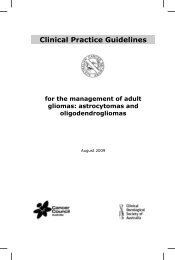Clinical Practice Guidelines for the management of locally advanced ...
Clinical Practice Guidelines for the management of locally advanced ...
Clinical Practice Guidelines for the management of locally advanced ...
Create successful ePaper yourself
Turn your PDF publications into a flip-book with our unique Google optimized e-Paper software.
Recently, <strong>the</strong>re have been reports <strong>of</strong> osteonecrosis <strong>of</strong> <strong>the</strong> jaw in patients undergoing treatment with<br />
bisphosphonates. In a case series <strong>of</strong> patients undergoing treatment with bisphosphonates <strong>for</strong> a variety<br />
<strong>of</strong> cancers, Bamias et al 2005 43 reported an incidence <strong>of</strong> 6.7% <strong>for</strong> osteonecrosis <strong>of</strong> <strong>the</strong> jaw, and an<br />
incidence <strong>of</strong> this condition in 6.5% <strong>of</strong> men with prostate cancer. They identified length <strong>of</strong> exposure as<br />
<strong>the</strong> most important risk factor and that zoledronic acid may be more prone to produce this<br />
complication than pamidronate. In a recent publication <strong>of</strong> a cohort study with matched controls,<br />
Wilkinson et al 2007 44 have confirmed <strong>the</strong> earlier case series reports. They showed that cancer<br />
patients treated with intravenously administered nitrogen containing bisphosphonates had an absolute<br />
risk at six years <strong>for</strong> any jaw toxicity <strong>of</strong> 5.48% compared with matched controls, who had an absolute<br />
risk <strong>of</strong> 0.30%. When adjustments were made <strong>for</strong> a number <strong>of</strong> potential confounders, <strong>the</strong> hazard ratio<br />
was 11.48 (95% CI = 6.49 to 20.33). They also confirmed that length <strong>of</strong> exposure was a risk factor <strong>for</strong><br />
jaw toxicity with those receiving 14–21 infusions <strong>of</strong> bisphosphonates significantly more likely to<br />
experience jaw toxicity than those who received less than three infusions (hazard ratio = 3.02 with<br />
95% CI = 1.28 to 7.10). They were unable to find a clear association between types <strong>of</strong> cancer,<br />
comorbidities, or with known risk factors <strong>for</strong> jaw and facial bone disease such as diabetes, alcoholism,<br />
smoking, obesity, hyperlipidaemia or parenteral corticosteroids.<br />
Atrial fibrillation may also be a concern. In a RCT <strong>of</strong> once-yearly infusions <strong>of</strong> zoledronic acid <strong>for</strong> <strong>the</strong><br />
treatment <strong>of</strong> post-menopausal osteoporosis, <strong>the</strong>re was a significant increase in ‘serious’ atrial<br />
fibrillation. 45<br />
Recommendations<br />
Zoledronic acid may be considered <strong>for</strong> <strong>the</strong> prevention <strong>of</strong> skeletal-related events in men with<br />
asymptomatic or mildly symptomatic hormone-resistant or castrate-resistant metastatic<br />
prostate cancer. Men, as part <strong>of</strong> <strong>the</strong> in<strong>for</strong>med consent process, should be made aware that<br />
nine men will need to be treated <strong>for</strong> one to achieve a benefit, and that <strong>the</strong>re is a risk <strong>of</strong><br />
osteonecrosis <strong>of</strong> <strong>the</strong> jaw occurring during treatment. Dental review is advised and be sought<br />
be<strong>for</strong>e commencing treatment.<br />
Renal function needs to be monitored during treatment. Ideally treatment should be<br />
confined to men whose serum creatinine is less than 265umol/L at <strong>the</strong> time <strong>of</strong> starting<br />
treatment.<br />
Grade B<br />
On <strong>the</strong> basis <strong>of</strong> <strong>the</strong> available evidence, bisphosphonates are not recommended <strong>for</strong> routine<br />
palliation <strong>of</strong> symptomatic bone disease in men, with hormone-resistant prostate cancer with<br />
a possible exception <strong>of</strong> zoledronic acid, where <strong>the</strong>re is some evidence <strong>of</strong> a benefit in<br />
castrate-resistant men.<br />
Grade C<br />
In Australia, zoledronic acid (4mg in 5ml) is <strong>the</strong> only bisphosphonate listed on <strong>the</strong> PBS <strong>for</strong> ‘bone<br />
metastases from hormone-resistant prostate cancer with demonstration <strong>of</strong> biochemical progression <strong>of</strong><br />
disease despite maximal <strong>the</strong>rapy with hormonal treatments’. It is also listed along with clodronate <strong>for</strong><br />
<strong>the</strong> ‘treatment <strong>of</strong> hypercalcemia <strong>of</strong> malignancy refractory to anti-neoplastic <strong>the</strong>rapy’.<br />
( accessed 3/06/2009).<br />
83<br />
Castration-resistant prostate cancer



